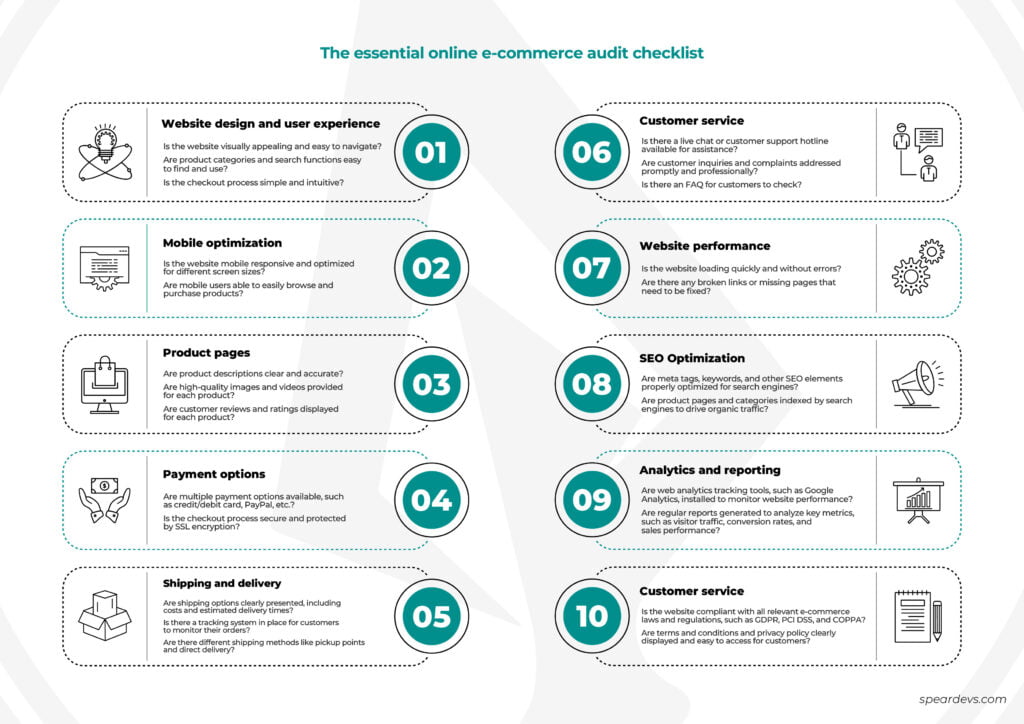Have you ever done an online e-commerce audit? If not, this article is definitely for you.
Partial and full auditing should be a standard in the lifecycle of any software project. This article will just scratch the surface of the topic but is a good start for anyone who is not familiar with it.
Understanding e-commerce audits
There are many things that you should check when auditing your e-commerce. It often depends on the current situation of the e-commerce platform but also its type.
What is an online e-commerce audit?
To put it simply, an online e-commerce audit is a complete evaluation of your online store. It helps identify areas for improvement. This analysis can uncover hidden problems that influence sales or customer satisfaction.
What’s more important, it lets you address issues and unlock new growth opportunities.
When to conduct an online e-commerce audit?
Generally speaking, the first audit should happen right after the go-live of the new platform. It is worth considering hiring an external agency to get the most out of it.
Even if you’re sure your project is well-tailored to your needs, there may be parts missing that your team may not be aware of.
- After launching your new platform: A post-launch audit ensures everything is functioning as intended.
- When you suspect issues: If you feel something’s off but can’t pinpoint the problem, an audit can provide valuable insights.
- Regularly: Regular checkups help maintain optimal performance and identify areas for ongoing improvement.
Areas to check during your e-commerce audit
Your online store is the heart of your business, but just like any engine, it needs regular check-ups to run at its best.
Here are the key areas to check during your e-commerce audit:
Functionality review
Normally done by manual testers with some help of automatic tests. It prevents the situation of bugs in features that have been done a while ago. Also, remember to check the most popular customers’ behaviors like a whole purchase path. Do not forget about UX and UI of the website itself.
Ensures all the features work as expected. Here’s what it entails:
- Manual and automated testing:
A combination of manual and automated testing helps identify bugs across different functionalities. It invovles checking if features implemented even long ago are still working as intended. - Customer journey mapping
Here you should focus on the entire purchasing path. This should be done in a way analogous to typical customer behavior. It includes checking functionalities like:- product search and filtering,
- adding items to the cart,
- or completing the checkout process.
- User Experience (UX) and User Interface (UI) assessment:
This one goes beyond just functionalities. In this part, you should check how easy it is for customers to navigate your site and find what they are looking for. It also evaluates visual appeal and overall user experience to ensure a pleasant shopping experience.
SEO audit
This is simple but often forgotten by smaller e-commerces. Check your performance in the following areas:
- Search engine performance:
Check how well your website performs in search results for relevant keywords. - Technical SEO
Delve into the technical aspects of your website that can impact search ranking. It includes:- checking for broken links (links that lead to non-existent pages),
- error codes (like 404 “Page Not Found” errors),
- and optimizing elements like image sizes and website structure.
- Content optimization
Review your website’s content, looking for ways to improve descriptions and product information to make them more search-engine friendly. Additionally, take a look at the accessibility features, ensuring your website is usable by everyone. - Robot.txt, metadata, and sitemap
These are technical aspects that guide search engines in crawling and indexing your website. These elements should be configured properly to help search engines understand your website’s content.
Technical audit
One of the most important for long-term projects. It involves:
- Code review
We’re not saying that rewriting your entire project is a good idea, but sometimes certain pieces of your code definitely need to be taken into consideration. Especially some libraries or plugins that are causing problems or issues with performance.
You should check your code for outdated elements, plugins, or functionalities. They all might be slowing down your website or causing security vulnerabilities. - Best practices
Ensure your website is built following best practices for website development. This helps maintain optimal performance, speed, and scalability as your business grows. - Security audit
Nowadays there are strict rules on how to secure the data of your clients, let’s be sure that your e-commerce are covering them all. Verify your website adheres to data security regulations and protects customer information. The audit identifies any potential security risks and suggests solutions to keep your website and customer data safe.
Benefits of conducting an e-commerce audit
- Early detection of performance issues
- Enhanced buying journey for customers
- Improved search engine visibility
- Identifying potential security risks
- Enhancing site performance
- Identifying friction in the buying journey
- Identifying cross-selling opportunities
- Evaluation of technical debt
- Review of the outsourced projects or modules
Why conduct an online e-commerce audit?
There are many reasons to conduct an online e-commerce audit. To begin with, it is a good idea to double-check the results of the outsourced project. If you don’t have your development team it is highly recommended to hire a third party to check the final solution.
Often, owners of an e-commerce platform are thinking about auditing their online shop when they feel that something is not working correctly but can’t quite put their finger on it.
A less common but still popular situation is when the company owners or stakeholders are not involved in day-to-day work in the e-commerce business and they want to understand the general situation of their business.
I would like us to treat our e-commerce like we treat our cars. One general audit once a year wouldn’t hurt that much and could prevent future problems.
~ Bartosz Guździoł, CEO at SpearDevs
Key areas to analyze in an e-commerce audit
Technology and website performance
- Analyze website technology stack.
- Evaluate website performance metrics.
- Technical debt
- Issues with plugins
- Outdated solutions, code, or integrations/libraries
- Coverage of automatic tests
Website design and User Experience
- Assess website design elements
- Evaluate user experience across devices
- Abandoned carts and pages
- AB tests
Technical SEO & on-page SEO
- Analyze SEO elements such as metadata, headings, and keyword optimization
- Assess website structure and internal linking
- Check if the website displays correctly and works well on all devices
- Image compression techniques and proper alt text implementation
- Page speed – optimizing image sizes, caching mechanisms, code modification
- Configuration of Robots.txt and sitemap correctness
Security
- Identify potential security vulnerabilities
- Ensure the implementation of secure protocols
- Guarantee GDPR regulations
- Check popular breaches and outdated plugins
- Server-side security
The essential online e-commerce audit checklist
- Website design and user experience:
- Is the website visually appealing and easy to navigate?
- Are product categories and search functions easy to find and use?
- Is the checkout process simple and intuitive?
- Mobile optimization:
- Is the website mobile responsive and optimized for different screen sizes?
- Are mobile users able to easily browse and purchase products?
- Product pages:
- Are product descriptions clear and accurate?
- Are high-quality images and videos provided for each product?
- Are customer reviews and ratings displayed for each product?
- Payment options:
- Are multiple payment options available, such as credit/debit card, PayPal, etc.?
- Is the checkout process secure and protected by SSL encryption?
- Shipping and delivery:
- Are shipping options clearly presented, including costs and estimated delivery times?
- Is there a tracking system in place for customers to monitor their orders?
- Are there different shipping methods like pickup points and direct delivery?
- Customer service:
- Is there a live chat or customer support hotline available for assistance?
- Are customer inquiries and complaints addressed promptly and professionally?
- Is there an FAQ for customers to check?
- Website performance:
- Is the website loading quickly and without errors?
- Are there any broken links or missing pages that need to be fixed?
- SEO optimization:
- Are meta tags, keywords, and other SEO elements properly optimized for search engines?
- Are product pages and categories indexed by search engines to drive organic traffic?
- Analytics and reporting:
- Are web analytics tracking tools, such as Google Analytics, installed to monitor website performance?
- Are regular reports generated to analyze key metrics, such as visitor traffic, conversion rates, and sales performance?
- Legal compliance:
- Is the website compliant with all relevant e-commerce laws and regulations, such as GDPR, PCI DSS, and COPPA?
- Are terms and conditions and privacy policy clearly displayed and easy to access for customers?

Pro tips for optimizing your online e-commerce audit
Some tools can make auditors life easier, for example:
Website performance and mobile friendliness:
- Google PageSpeed Insights and GTmetrix
These free tools provide valuable insights into website loading speed and performance metrics. They also offer recommendations for improvement. - Google’s Mobile-Friendly Test
As the name suggests, this simple tool from Google lets you check if your website displays correctly on mobile devices.
Website crawling and SEO analysis:
- Screaming Frog
This tool can analyze your website’s structure, identify broken links, and check for basic on-page SEO elements. - Ahrefs, SEMrush and Moz
These SEO powerhouses offer advanced features for analyzing your website’s backlink profile, competitor research, and keyword research.
Technical SEO and content optimization:
- Google Search Console and SEMrush
Both Google Search Console (free) and SEMrush (paid) provide valuable insights into your website’s SEO performance from a search engine’s perspective. They can help identify technical SEO issues like crawl errors and indexation problems.
Code quality analysis:
- SonarQube and similar tools
For developers, code quality analysis tools like SonarQube can help identify potential code bugs, security vulnerabilities, and areas for code improvement.
User Experience (UX) analysis:
- Hotjar and similar tools
These tools provide valuable insights into how customers interact with your website. Using heatmaps, session recordings, and form analytics, you can identify areas of frustration and optimize the user experience.
Remember: These are just a few examples, and the best tools for your audit will depend on your specific needs and budget.
E-commerce audit example
Now that you’ve explored the key areas of an e-commerce audit, you might be wondering what it looks like in practice. Here’s a glimpse into a quick e-commerce audit we did for Zeszytowiec.pl.
Summary
E-commerce audits are essential for online store health. They can uncover hidden issues impacting sales or customer satisfaction. By addressing these issues, you can enhance the customer buying journey, improve search engine visibility, and ensure better website performance. In fact, e-commerce audits help you to optimize your online store and as a result – grow.
GET IN TOUCH
Need a comprehensive audit of your website?
Our team will identify areas for improvement and provide a clear roadmap for optimization. Contact us today to discuss your needs.
Online e-commerce audit FAQ
What is an e-commerce audit?
An E-commerce audit is a general test for an online shop, both technical and functional. It is similar to a website audit, the main difference is that e-commerce has often specific functionalities and customer paths that should be considered during the audit.
How to do an audit on a website?
The best way to do the audit is to hire an external company that is not involved in your website development so the results are not biased. Also, proper audits should be done by several different specialists.
What is a website audit?
Similar to an e-commerce audit. Websites are often more versatile and their UX/UI is often out of the box so that part could differ a lot.
Can the audit be done online?
The only offline parts that could be audited are logistics and offline stores. This can be a convenient and cost-effective option for companies and auditors.
How to do a sales audit?
- Define the purpose of the sales audit
- Identify key performance indicators (KPIs)
- Gather data
- Analyze the data
- Compare results to benchmarks
- Identify strengths and weaknesses
- Develop an action plan
- Implement changes
- Regularly review and update
How to do an SEO audit?
- Start with a website crawl
- Check your website’s on-page SEO
- Assess your website’s backlink profile
- Evaluate your website’s content
- Analyze your website’s mobile-friendliness
- Check your website’s site speed
- Review your website’s technical SEO
- Monitor your website’s search engine rankings
- Create an action plan
Is a website audit necessary?
In theory no but it is highly recommended. It is just a matter of calculated risk. Many projects are avoiding proper documentation or automatic testing but in the end, all those processes could help avoid issues that could be a high cost. Often the proper website audit can prevent a disaster.
How much does a website audit cost?
There is no simple answer to that question as the complexity of a website and its processes are the main factor of the costs. Our audit offer starts from 3450 PLN netto for a basic audit and includes:
- manual testing of the whole page
- basic SEO audit (review of SEO and performance issues)
- technical review (general review of the code and best practices)




















